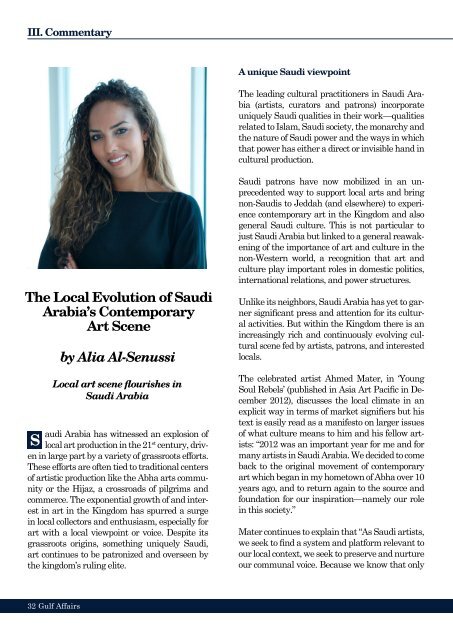Create successful ePaper yourself
Turn your PDF publications into a flip-book with our unique Google optimized e-Paper software.
III. Commentary<br />
A unique Saudi viewpoint<br />
The leading cultural practitioners in Saudi Arabia<br />
(artists, curators and patrons) incorporate<br />
uniquely Saudi qualities in their work—qualities<br />
related to Islam, Saudi society, the monarchy and<br />
the nature of Saudi power and the ways in which<br />
that power has either a direct or invisible hand in<br />
cultural production.<br />
The Local Evolution of Saudi<br />
Arabia’s Contemporary<br />
Art Scene<br />
by Alia Al-Senussi<br />
Local art scene flourishes in<br />
Saudi Arabia<br />
audi Arabia has witnessed an explosion of<br />
S local art production in the 21 st century, driven<br />
in large part by a variety of grassroots efforts.<br />
These efforts are often tied to traditional centers<br />
of artistic production like the Abha arts community<br />
or the Hijaz, a crossroads of pilgrims and<br />
commerce. The exponential growth of and interest<br />
in art in the Kingdom has spurred a surge<br />
in local collectors and enthusiasm, especially for<br />
art with a local viewpoint or voice. Despite its<br />
grassroots origins, something uniquely Saudi,<br />
art continues to be patronized and overseen by<br />
the kingdom’s ruling elite.<br />
Saudi patrons have now mobilized in an unprecedented<br />
way to support local arts and bring<br />
non-Saudis to Jeddah (and elsewhere) to experience<br />
contemporary art in the Kingdom and also<br />
general Saudi culture. This is not particular to<br />
just Saudi Arabia but linked to a general reawakening<br />
of the importance of art and culture in the<br />
non-Western world, a recognition that art and<br />
culture play important roles in domestic politics,<br />
international relations, and power structures.<br />
Unlike its neighbors, Saudi Arabia has yet to garner<br />
significant press and attention for its cultural<br />
activities. But within the Kingdom there is an<br />
increasingly rich and continuously evolving cultural<br />
scene fed by artists, patrons, and interested<br />
locals.<br />
The celebrated artist Ahmed Mater, in ‘Young<br />
Soul Rebels’ (published in Asia Art Pacific in December<br />
2012), discusses the local climate in an<br />
explicit way in terms of market signifiers but his<br />
text is easily read as a manifesto on larger issues<br />
of what culture means to him and his fellow artists:<br />
“2012 was an important year for me and for<br />
many artists in Saudi Arabia. We decided to come<br />
back to the original movement of contemporary<br />
art which began in my hometown of Abha over 10<br />
years ago, and to return again to the source and<br />
foundation for our inspiration—namely our role<br />
in this society.”<br />
Mater continues to explain that “As Saudi artists,<br />
we seek to find a system and platform relevant to<br />
our local context, we seek to preserve and nurture<br />
our communal voice. Because we know that only<br />
32 Gulf Affairs


